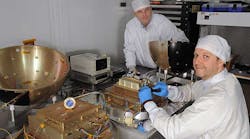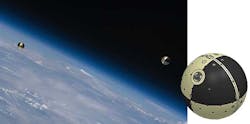Engineers at the U.S. Naval Research Laboratory (NRL) have built a beach-ball sized satellite, called SpinSat, which will begin carrying out several duties soon after it is flown to the International Space Station aboard a SpaceX resupply mission and launched into space. Its primary goal is to help researchers evaluate a new type of ion thruster developed by Digital Solid Sate Propulsion Inc. The satellite will also be used to calibrate and test the limits of the International Laser Ranging Service (ILRS), a space surveillance network that monitors the orbit of spacecraft. Finally, scientitsts will record and analyze the drag on the SpinSat as it flies low-Earth orbits to develop a better model of Earth’s atmospheric density at high altitudes.
SpinSat is a nearly spherical satellite about the size of a beach ball—only it weighs about 100 lb. Its aluminum skin is covered in a four-section, beach-ball-like pattern of gold iridite and anodized black. The gold sections reflect sunlight while the black ones absorb it. Therefore, when the SpinSat spins, it can maintain thermal stability. It will be launched from outside the ISS by Cyclops, a spring-powered device that will push SpinSat off into space.
The satellite carries 12 sets of six thrusters and a total of 1.5 ounces of nonmetalicized electric propellant. The propellant is environmentally friendly, with low volatility and it emits no noxious fumes. An onboard battery supplies power to the thrusters; the more power applied, the more thrust they produce. The thrusters can be stopped and restarted several times and are said to have a life of 250 thrust pulses; an average thrust of 0.07 lb, and a thrust pulse of 2 msec. The NRL is confident that the fuel will last for the six-month portion of the mission that requires spinning and de-spinning SpinSat and taking it to higher and lower orbits around Earth.
The satellite also has retroreflectors studded across its surface. These are corner cubes made of three flat mirrors. When a light beam, or laser, goes into one of them, it gets reflected in a way that sends returning beams back in the opposite direction they came from. This lets researchers on Earth triangulate SpinSat’s position within millimeters. They can also determine how fast it is spinning by bouncing lasers off several retroreflectors. An onboard spin detector will give researchers accurate readings with which to check calculations from triangulation. By precisely controlling the satellite’s speed and spin, researchers hope to discover how much of a change in speed, direction, or spin rate the IRLS can detect.
The mission should be over in two years, and then SpinSat will fall back into Earth’s atmosphere and burn up.

